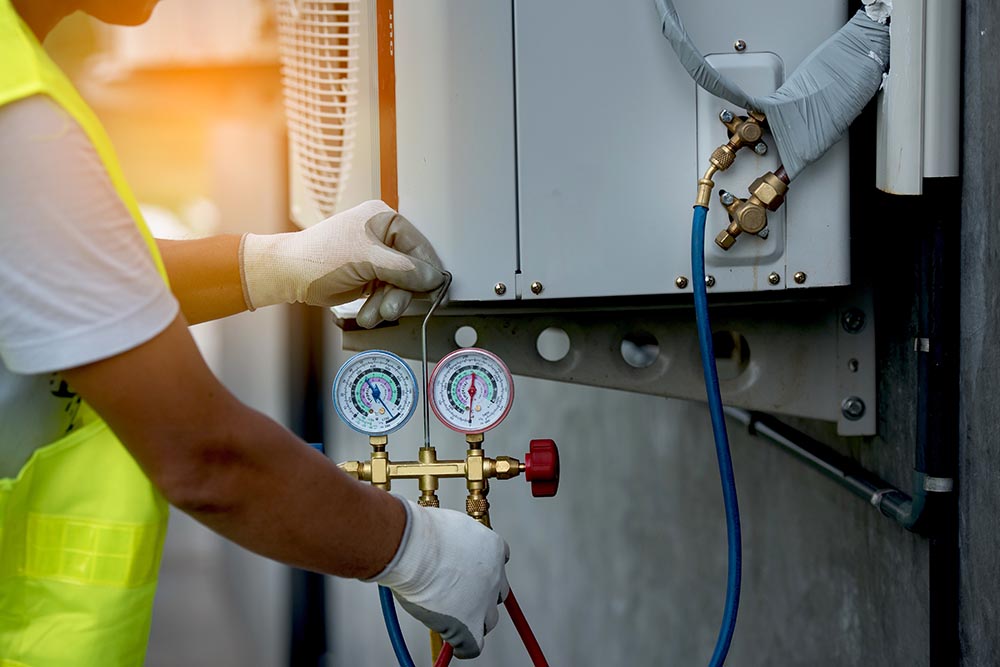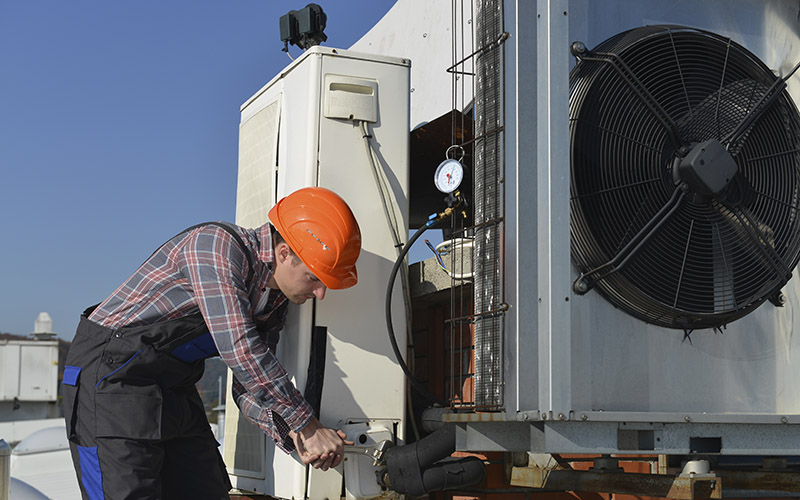Essential Insights About ductless mini splits Before You Upgrade
Wiki Article
Exactly How a Warmth Pump and Heating System Interact to Enhance Your Home's Heating Performance
Understanding how a warmth pump and heater job with each other is essential for homeowners looking for reliable home heating services. Each system has its toughness, providing a well balanced approach to home convenience. The heatpump succeeds in modest temperatures, while the heating system supplies quick warmth throughout severe cold. This synergy not only minimizes power costs but also enhances the life expectancy of both appliances. What variables influence this partnership, and just how can property owners maximize their benefits?Comprehending Warmth Pumps: Just How They Function
Several people might be unfamiliar with their inner functions, warmth pumps play an essential role in modern home heating systems. These tools operate by transferring warm from one area to an additional, using the concepts of thermodynamics. In colder months, a warmth pump extracts warm from the outdoors air, ground, or water, and transfers it inside your home to warm the living space. Alternatively, throughout warmer months, it can turn around the process, serving as an air conditioner by getting rid of warm from inside to the outside.Heat pumps contain an evaporator, development, condenser, and compressor valve. The cooling agent within the system soaks up heat as it vaporizes at low temperature levels and pressures. The compressor then increases the stress and temperature level of the cooling agent, allowing it to release warm as it condenses. This effective procedure can considerably minimize energy intake contrasted to typical heating approaches, making heatpump a sustainable option for environment control in homes.The Role of Heaters in Home Home Heating
Furnaces play an important function in home heating by offering a dependable resource of warmth throughout the chillier months. They run by generating warm via combustion or electric resistance, distributing it throughout the home using ducts or radiant systems. The performance of a heating system is often gauged by its Yearly Gas Utilization Performance (AFUE) score, which indicates exactly how successfully the device converts fuel right into heat.Furnaces can utilize numerous power resources, including all-natural gas, oil, electricity, or gas, enabling house owners to pick one of the most appropriate option for their requirements. Unlike warmth pumps, which might have a hard time in severe chilly, furnaces preserve consistent efficiency, making sure that indoor temperature levels stay comfy no matter exterior conditions. In addition, contemporary heaters usually come equipped with advanced technology, such as clever thermostats and variable-speed blowers, enhancing their effectiveness and responsiveness. This adaptability makes heating systems a critical part in all-inclusive home heating approaches.
Advantages of Utilizing Both Equipments Together
Incorporating the strengths of both heaters and warm pumps can cause a much more reliable and reliable home heating option. Making use of both systems permits property owners to capitalize on the warm pump's power efficiency throughout milder temperature levels while counting on the furnace for even more severe cold conditions. This dual strategy can substantially decrease energy prices, as warm pumps eat less power than conventional heating techniques when temperature levels are moderate.Additionally, making use of both systems together can enhance comfort levels in the home. Heatpump can offer consistent, also heating, while heaters can rapidly raise ambient temperatures when needed. The combination of both systems can extend the life expectancy of equipment by minimizing wear and tear on each unit, as they share the workload. Ultimately, home owners can enjoy a balanced, cost-efficient heating option that adjusts flawlessly to differing climate conditions, making sure a warm and inviting home throughout the winter season.How Warmth Pumps and Furnaces Enhance Each Various Other
When house owners integrate warmth pumps and furnaces, they produce a complementary heater that takes full advantage of efficiency and comfort. Heatpump run by moving heat from the outdoors air or ground, making them very reliable in moderate climates. They excel throughout milder temperatures, supplying cost-efficient home heating. Conversely, heating systems produce heat via burning or electric resistance, providing strong, instant warmth during extreme cool conditions.The combination of these two systems enables dynamic adjustments based upon temperature level changes. During warmer months or milder winter days, the heatpump can take the lead, saving energy and decreasing costs. As temperatures decrease, the heater can perfectly engage, making sure consistent heat throughout the home. This synergy not just optimizes energy usage yet also improves the life-span of both systems, as each unit operates within its ideal efficiency array. Together, they develop a well balanced atmosphere that adjusts to differing climate demands.
Enhancing Performance: Tips for Homeowners
Homeowners can boost their heating performance with numerous functional techniques. Establishing a normal maintenance schedule, integrating smart thermostat innovation, and executing effective insulation and sealing options are vital actions. These measures not just improve convenience however also reduce power expenses.Normal Maintenance Schedule
To assure optimal heating efficiency, establishing a routine maintenance timetable is vital for any type of home. Property owners must prioritize routine assessments of both heatpump and heaters to ascertain peak efficiency. This consists of transforming air filters every one to 3 months, as clogged up filters can greatly lower efficiency. In addition, scheduling expert upkeep at the very least yearly enables service technicians to determine and address prospective problems prior to they escalate. Property owners need to likewise clean up the heat pump's outside device to avoid particles build-up that can prevent airflow. By sticking to a normal upkeep schedule, homeowners not just boost their heater' effectiveness yet additionally extend their life expectancy, resulting in higher convenience and lowered energy expenses throughout the colder months.Smart Thermostat Integration
Integrating a wise thermostat into a home furnace can greatly enhance energy performance, particularly as it permits precise control over temperature settings. These devices can learn the homeowner's timetable and choices, instantly changing the temperature to optimize comfort while decreasing power usage. For instance, they can lower home heating during times when the home is empty, decreasing unneeded consumption. Several wise thermostats also offer real-time energy use information, enabling house owners to make enlightened decisions concerning their home heating habits. Furthermore, remote accessibility through smartphone applications enables customers to adjust settings from anywhere, guaranteeing the home is cozy upon return. In general, wise thermostat integration not only boosts convenience but significantly contributes to energy savings and performance.
Insulation and Securing Solutions
Smart thermostats play an essential function in power efficiency, yet their performance can be significantly improved by correct insulation and sealing solutions. Homeowners ought to prioritize shielding attic rooms, wall surfaces, and floorings to reduce warmth loss. High-grade insulation products, such as spray foam or fiberglass, can greatly improve thermal resistance. Additionally, securing gaps around ducts, windows, and doors avoids cold air infiltration and heat retreat. Weatherstripping and caulking work approaches for addressing these leaks - furnace replacement. Normal assessments for air leaks, together with making use of blower door examinations, can help identify trouble areas. By buying insulation and securing, home owners can enhance the efficiency of their heater, eventually resulting in minimized energy consumption and reduced energy billsUsual Misconceptions Regarding Heat Pumps and Furnaces
What mistaken beliefs border heatpump and heaters? Several people mistakenly believe that warmth pumps are inadequate in colder climates. In fact, modern-day heat pumps are created to run efficiently also in reduced temperatures, supplying dependable heating go to this web-site throughout winter. An additional usual misconception is that heaters are constantly a lot more effective than heatpump. However, this depends upon the particular power resources and effectiveness ratings of the devices concerned. Some might additionally assume that using both systems at the same time is unneeded, yet as a matter of fact, this combination can maximize heating performance, especially throughout extreme weather. Additionally, individuals typically think that warmth pumps discover this call for consistent maintenance, when in truth, they have comparable upkeep needs to traditional heating systems. By unmasking these misconceptions, homeowners can make even more educated decisions concerning their heating options, ultimately causing enhanced comfort and energy efficiency in their homes.Maintenance Factors To Consider for Combined Equipments

Often Asked Concerns
Can Warmth Pumps Work Effectively in Exceptionally Cold Climates?
Heatpump can struggle in extremely cold climates as a result of decreased performance and heat removal limitations. However, advancements in technology have led to designs created for better performance in such conditions, enhancing their stability in rough settings.
How Much Time Do Warm Pumps and Furnaces Commonly Last?
Heatpump usually last 15 to two decades, while furnaces have a lifespan of 15 to three decades. Routine upkeep can extend their long life, making certain effective procedure more info here and decreasing the need for premature replacements.
What Is the Ordinary Price of Setting Up Both Systems?
The ordinary price of installing both a warm pump and a heating system usually varies in between $5,000 to $10,000 - heat pump installation ooltewah tn. Variables influencing this expense include system size, installation intricacy, and regional labor ratesAre There Tax Rewards for Utilizing Energy-Efficient Heating Equipments?
Numerous property owners ask about tax obligation incentives for energy-efficient heating unit. Various federal and state programs usually offer discounts or credit ratings, encouraging the fostering of sustainable innovations to minimize energy intake and promote ecological duty.Just how Do I Choose the Right Dimension Warm Pump and Heater?
Choosing the appropriate dimension heatpump and heater includes computing the home's square footage, thinking about insulation top quality, and examining neighborhood climate. Consulting a specialist can assure suitable system performance and energy efficiency based on specific demands. heat pump service. Recognizing just how a warmth pump and furnace work with each other is important for property owners seeking effective heating services. In colder months, a warm pump extracts warm from the outdoors air, ground, or water, and transfers it inside to warm up the living area. When home owners incorporate warm pumps and heating systems, they produce a complementary heating system that takes full advantage of efficiency and convenience. Warm pumps run by moving warm from the outdoors air or ground, making them highly reliable in moderate climates. Warm pumps can have a hard time in extremely chilly climates due to lowered efficiency and warmth extraction constraintsReport this wiki page